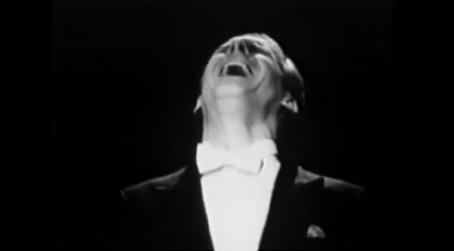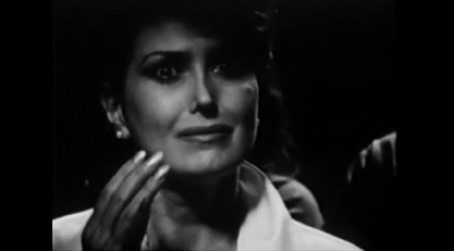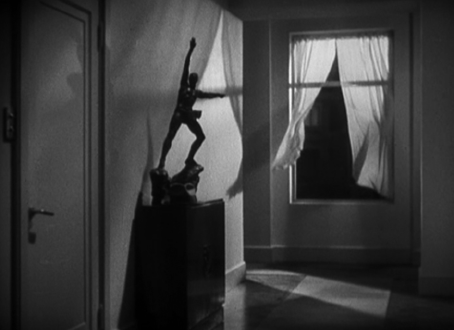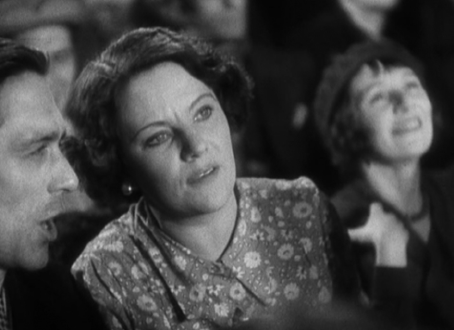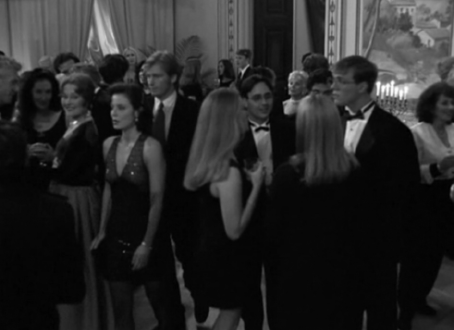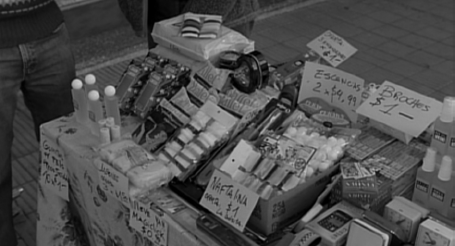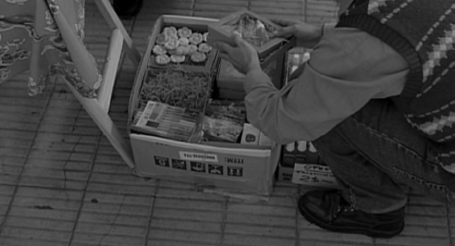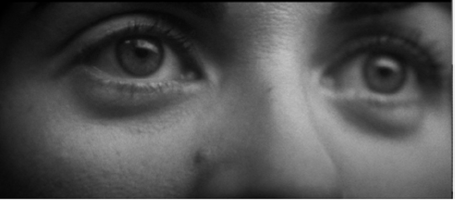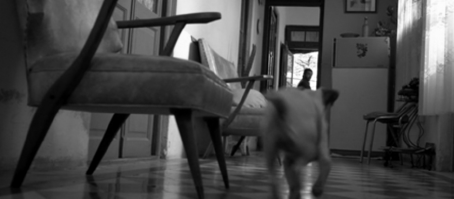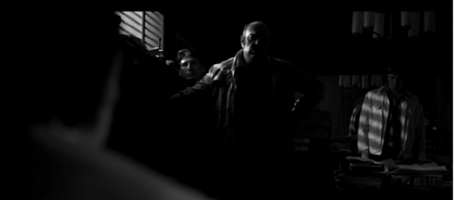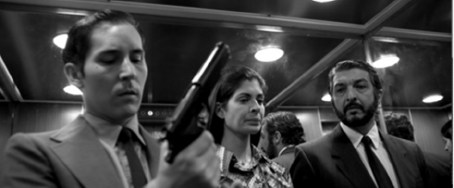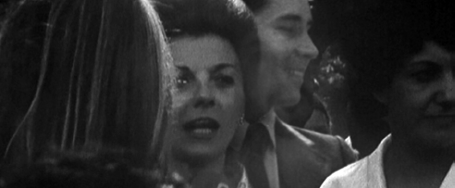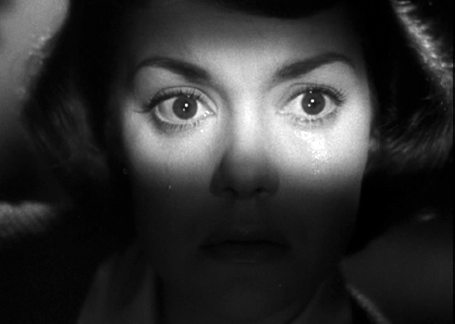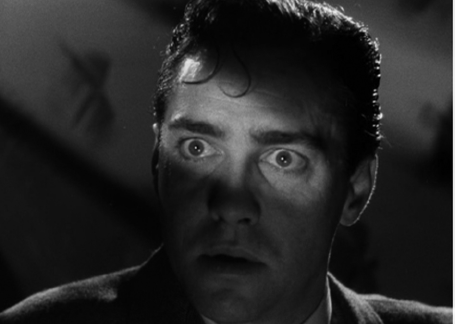I. INTRODUCTION TO ‘OSMOSIS’
At the press conference of the 2009 San Sebastián Film Festival for Juan José Campanella’s film El secreto de sus ojos (The Secret in Their Eyes) I asked the Argentinean director whether he was influenced by Hitchcock. His quick answer was ‘¿Quién no ha sido influenciado por Hitchcock? Por osmosis’ (‘Who hasn’t been influenced by Hitchcock? By osmosis’). He then responded to what had been my lead-in to this question, first a comment that The Secret in Their Eyes was an amazing film because of the tension between a particularly Argentinean sense of humour and the thriller genre, which characterises Hitchcock’s work, and second a query about at what stage in the filmmaking process this tension between comedy and drama primarily developed. Campanella went on to acknowledge and comment on the importance of what he called the ‘balance’ between humour and drama in his films. Moreover he described his working process, ‘Tiendo a escribir más comedia de lo que se filma’ (‘I tend to write more comedy than what gets filmed’). This chapter will analyse elements of Campanella’s career that make him a Latin Hitchcock, addressing both television and film, and explore the Hitchcockian traces in The Secret in Their Eyes. The strategy will not be to suggest direct quotations of Hitchcock’s films, although we will develop analogies to specific movies, but rather to show how characteristics of Hitchcock’s cinematography pervade Campanella’s work and shape it at its most meaningful junctures. To recall, Argentina, Mexico and Cuba have historically had the most developed film industries in Latin America. To consider this process of ‘osmosis’ in a historical and political context will allow us to appreciate both the unique characteristics of the reception of Hitchcock in an important region of Latin America and to address the role of the transnational or crossover in building a career as a filmmaker in Argentina.
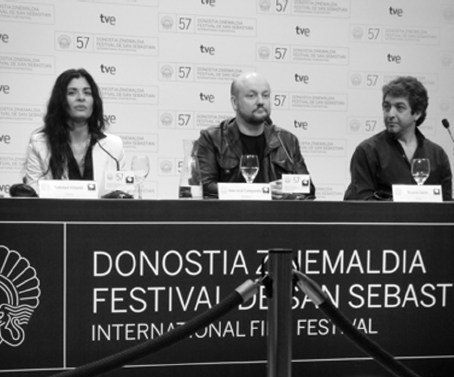
José Juan Campanella between Soledad Villamil and Ricardo Darín at the press conference for The Secret in Their Eyes at the 2009 San Sebastián Film Festival.
If in the course of this book we were to discuss only directors who looked to Hitchcock as an initial model for becoming successful directors, especially through crossover or transnational recognition – that is, to build their careers on Hitchcock’s model – then Juan José Campanella (b.1959) might be left out because of his anomalous genre choices. For the past two decades Campanella’s reputation has never been as a director particularly associated with Hitchcock. He achieved worldwide recognition with his third film El hijo de la novia (The Son of the Bride, 2001), an upbeat, even sunny melodrama that was nominated for the Best Foreign Film Academy Award, a huge achievement in Latin America. Yet there is a darker side to Campanella’s work in film, and equally importantly in television, that has received much less attention. Indeed ‘Joe’ Campanella is a successful mainstream Argentinean director who at significant moments modelled his crossover career on Hitchcock’s. One turning point happened at the movies when he was in his twenties.
II. EARLY CAREER DIRECTIONS: CROSSING OVER FOR FILM SCHOOL, HAVING THE LAST LAUGH WITH THE CONTORTIONIST
Campanella claims that seeing Bob Fosse’s film All That Jazz (1979) in Buenos Aires, on the very day he was set to enroll in his final year of engineering courses, made him decide to abandon his engineering studies and apply to the Tisch School of the Arts at NYU to study film and become a director. All That Jazz could serve as an emblem to Campanella’s approach to his work, for although it has an underlying darker tone, it was most often marketed for its more upbeat musical dazzle. Nonetheless, Campanella’s fascination with All That Jazz, a tale of artistic brilliance and self-destruction, and an ironic statement of directorial ego, did fit the mood of the times in Argentina. Many Argentineans, in particular many artists and intellectuals, were leaving the country for political reasons, as these were the years under military dictatorship called the Proceso (Process of Social Reintegration) or the Dirty War (1976–1983).
Although Campanella moved to the US for film school in 1983, the direction for his break into the international film industry was not immediately clear. The portfolio of projects in Spanish he brought with him to the US reflected Argentinean national political concerns. In 1979 Campanella wrote and filmed a 22-minute short in Spanish called Prioridad nacional (National Priority). He co-wrote and co-directed his first feature-length film, the Spanish-language docudrama Victoria 392 (Victory 392, 1984), with Fernando Castets. They filmed in Buenos Aires where the film opened in 1984, a year after Raúl Alfonsín’s election, which represented Argentina’s return to democracy.
Still, in the 1980s Campanella did make the most of his film studies in New York. For one, unlike Amenábar, a generational contemporary, he completed his degree programme. In crossing over to the US Campanella was being trained for a viable global industry while in Spain Amenábar felt he was studying the local habits of a commercial dinosaur. For another, in 1988 Campanella’s thesis film El contorsionista (The Contortionist) won the prize for best science fiction short at NYU. It was based on the comic book El contorsionista, written by the prolific Argentinean comic book writer Carlos Trillo and illustrated by Mandrafina.1 The film’s title is deceptive since it has nothing to do with full-body gymnastic contortionism, but rather with philosophical musings on what constitutes pleasure and performance.
The Contortionist tells the story of Bruce Bailey, ‘The Contortionist’, who is having a crisis over being able to perform on stage. In a nod to the thriller genre, Bailey is being physically pursued to perform. When he gets on the subway, a black man in the carriage puts a knife to his throat to force him to do his act there because the man does not have the money to see it in the theatre. Bailey refuses. In another scene, a streetwalker threatens him with a gun claiming he has a bounty on his head. Bailey overpowers her and she dies in his arms after the gun goes off. Subsequently inside a room he engages in a long conversation with a woman. As she stares out a window through tattered curtains, she recalls the old days when people watched ‘Let’s Make a Deal’ on television. (Implied is that in 2049 there is no television.) Nostalgically she remarks that the show’s participants joyfully picked the least practical choice behind the curtain. Bailey finally does go on stage and contorts his expression into a laugh. The film then cuts from a medium shot of Bailey’s laugh to multiple reaction shots of spectators contorting with emotion as well. For instance, in an expressionistically lit close-up an intense hypnotic gaze dominates one woman’s face as she reacts to Bailey’s stage performance. In his dressing room after the show Bailey receives a contract renewal, the last laugh indeed.
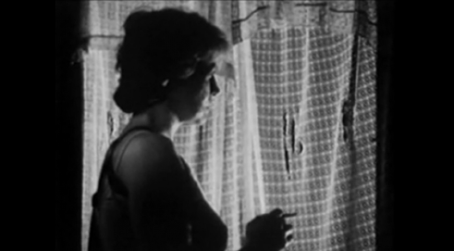
In an expressionistically lit frame in The Contortionist a woman stares out a window through tattered curtains and recalls ‘the old times’ when people watched ‘Let’s Make a Deal’ on TV.
Low-angle shot of Bailey on stage as he contorts himself into a laugh in The Contortionist.
High-contrast shot of a woman reacting intensely to Bailey’s performance in The Contortionist.
Although set in 2049, the black and white retro visual style of The Contortionist – emphasising extreme shadows, high contrast and nighttime urban decay – recalls not only Mandrafina’s noir comic book illustrations (see for example, a cover from La Iguana, written by Trillo and illustrated by Mandrafina) but also, as a filmic adaptation, an earlier period of German expressionism. Campanella’s aesthetic look for his apprenticeship film uncannily follows Hitchcock’s trajectory, for as the 2009 exhibition ‘Casting a Shadow: Alfred Hitchcock and His Workshop’ at the Deutsche Kinemathek Museum documents, Hitchcock served an important apprenticeship in Berlin with F. W. Murnau in 1924–25.2 Besides directing some of his first films, The Pleasure Garden (1925) and The Mountain Eagle (1926), in Germany,3 Hitchcock worked there as scriptwriter and art director on other silent melodramas and also observed Murnau filming his silent masterwork Der Letze Mann (The Last Laugh, 1924). This training in filmic technique impacted on Hitchcock’s visual style and was the foundation for his yeoman work ethic throughout his career. In choosing to adapt a graphic novel and its noir style, Campanella follows in Hitchcock’s German shadows in The Contortionist. It is likewise possible that the English title of Murnau’s film, The Last Laugh, inspired Campanella to begin his own American career with the tale of climactic laughter. Significantly the short’s narrative intersects not only with that of Murnau’s silent film but also with that of one of Hitchcock’s most famous black and white sound films.
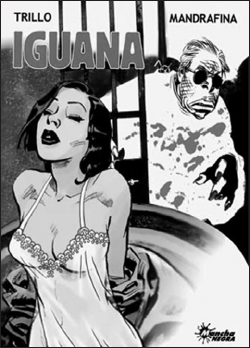
An example of Mandrafina’s noir cover art for the magazine Iguana.
Both the expressionist aesthetics and the plot of The Contortionist recall the early sequences of The Thirty-Nine Steps. Mr. Memory (Wylie Watson), like Bailey, is challenged by the audience to perform and put himself in a trance. The nature of their performances and their bond with the audience is subliminal. In Hitchcock, when a gun goes off in the theatre, a mysterious woman accosts the protagonist Richard Hannay and pleads with him to take her home with him. She hides from view by pulling the blinds in his rented room. Throughout the sequence the backlit curtains figure prominently in the mise-en-scène. Similarly in The Contortionist the scene with the woman by the curtain occurs after a gunshot at the theatre. In both films the theatrical or filmic performance serves as a frame story. In both the editing effectively creates suspense in the narrative of a fugitive. In both multiple reaction shots emphasise audience participation and laughter.
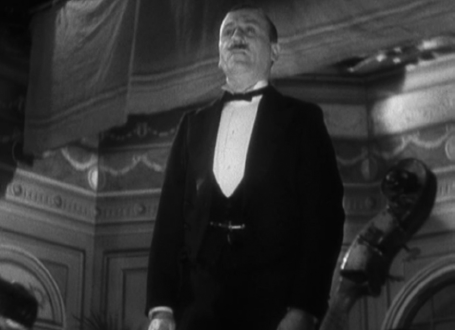
Low-angle, expressionist shot in The Thirty-Nine Steps: Mr. Memory is challenged by the audience to perform.
In The 39 Steps the curtains of the flat to which the mysterious woman brings Richard Hannay are filmed with high contrasts of dark and light.
Close-up of a woman in the audience asking Mr. Memory a question in The 39 Steps.
The response to Campanella’s short was strong. In 1989 it was selected to compete at the Festival of Clermont-Ferrand, the top international festival for shorts, where it won a special jury prize. This international exposure gave significant impetus to his career.4 His attention to the classics, particularly to the German expressionist style beloved by Hitchcock, was the underpinning of this success.
III. THE HITCHCOCKIAN PREQUEL THE BOY WHO CRIED BITCH AND OTHER LIFESTORIES OF ADOLESCENT VIOLENCE
In the early 1990s Campanella’s career took on an even more decidedly Hitchcockian turn. After graduating from film school, he stayed on in New York City and was given the opportunity to direct his first film in English, also his solo-directing debut, The Boy Who Cried Bitch (1991). Written, perhaps surprisingly, by a woman, Catherine May Levin, and supposedly based on an actual case, the film told the story of the adolescence of a sociopath or psychotic killer. Campanella said he ‘wanted to see what Charles Manson, the Hillside strangler, and John Hinckley were like as children’.5 The shock of the ‘b’ word in the film’s title sets the tone for the film’s transgressions.6 Although the fascination for serial killings and the aggressive tone recall Hitchcock’s Frenzy, Campanella most importantly begins to explore a paradoxical moral vision, of finding evil close to home, in The Boy Who Cried Bitch that is characteristic of Hitchock’s work. In Shadow of a Doubt and Frenzy, for example, Hitchcock explored the notion that evil, particularly serial killings, could be done by people such as Uncle Charlie who outwardly seem good and wholesome.
The film tells the coming of age story of the 12-year-old Dan Love who is sent to a prep school by his divorced mother who can no longer deal with him. Expelled from the prep school, due to his escapades with a Vietnam vet/maintenance man/child molester there, Dan is sent onto a children’s psychiatric hospital. There he falls in love with a young woman, a fellow patient. However he so disrupts the other patients that the hospital seeks to remove him. His mother, unwisely, agrees to let him come home to live with her; he slaughters her. Film critics from radically different perspectives found The Boy Who Cried Bitch both disturbing and convincing primarily because it repeats Hitchcock’s ‘persistent theme’ that ‘evil might dwell next door in Hitchcock’s world, or in one’s own household; there is no sanctuary’ (McGilligan 2003: 311). Writing for The Austin Chronicle (27 March 1992), Marc Savlov called the boy a ‘ferocious main character as a sort of teddy bear kid gone awry, for inexplicable reasons’ and the film ‘dangerously close to reality’ (http://www.austinchronicle.com/calendar/film/1992–03–27/the-boy-who-cried-bitch/). Writing for the online site ‘Spirituality and Practice’ (1991), Frederic and Mary Ann Brussat compared the film to an AMA report on adolescent psychological problems and drew the following lesson: ‘Up until its bloody and senseless finale, The Boy Who Cried Bitch offers a scary and gripping portrait of a disturbed boy who resists treatment and spreads his destructiveness in ever larger circles. Violence in the home breeds more violence is the message of this troubling film’ (https://www.spiritualityandpractice.com/films/films.php?id=6283).
The Boy Who Cried Bitch brought Campanella to the attention of cable television producers interested in filming reality projects about juveniles. Between 1992 and 1996 he directed six episodes of the HBO docudrama series Lifestories: Families in Crisis based on real cases of social problems of adolescents. His first episode was ‘No Visible Bruises: The Katie Koestner Story’ about date rape. As was customary in the series, after the fictionalised re-telling of the case the real person, for this episode Katie Koestner, appeared in a coda to the episode to provide more information and offer support to those who may find themselves in a similar situation, victims of sexual assault. That same year as ‘No Visible Bruises’, Campanella also directed ‘Dead Drunk: The Kevin Tunell Story’ about a drunk-driving vehicular homicide in Virginia that sparked the formation of MADD (Mothers Against Drunk Driving), and ‘A Child Betrayed: The Calvin Mire Story’ about the sexual molestation of a child by a priest. He won a Best Director Emmy for ‘A Child Betrayed’. With Lifestories, ‘serious’ television that had extensive impact in high school and college classrooms, Campanella mastered directing gritty material for television and worked with top-notch TV actors, such as Claire Danes who played Heidi Leitner, a lesbian coming out. Like Hitchcock later in his career Campanella developed a strong background in television. It also paid the bills, and kept him in contact with the US industrial network, truths of which Hitchcock was completely aware throughout his career, too. Moreover, just as Hitchcock’s television series coincided with the initial global acceptance of the medium, Campanella’s television work in the 1990s coincided with the diversification of the broadcast medium and the rise of cable throughout the world. Like Hitchcock, Campanella worked on the transformative edge of the industry. The skills he developed for television at this transformative stage carried over to his film work, too. This knowledge was simultaneously an advantage and a curse.
IV. NOT-NOIR BUT CLOSER TO NOTORIOUS: THE GENRE AND TONAL MIX OF LOVE WALKED IN
With his next film project, the US/Argentinean co-production Love Walked In (1997), Campanella began to explore other transnational opportunities. For his first attempt at writing a script in English for a feature-length narrative film he adapted the novel Ni el tiro del final (Neither the Final Shot, 1981) by the Argentinean writer José Pablo Feinmann, who received co-script writing credit on the movie. Despite keeping Feinmann’s title, which is a well-known tango verse, for the Argentinean release of the film, Campanella erased all Argentinean cultural specificity from the film.7 Only transnational Latin traces remained, exemplified best by the casting of the Spanish actress Aitana Sánchez-Gijón in the siren role of Vicky Rivas. She represented a generic Latina type, similar to the way another Spaniard, Antonio Banderas, passed as a credible Che Guevara in the film of the musical Evita (1996). Only minimal attempts were made to clarify her roots or explain her heavily accented English. Even when she spoke in Spanish to answer a phone call from her mother and insist she wasn’t going home yet, how or why the Spanish Vicky ended up in Long Island with Jack, or wanted to stay there, was left unsaid.
The pseudo-noir film Love Walked In opened at the 1997 Sundance Film Festival then was released internationally over the next two years. It tells the story of the money-making scheme of Jack Hanaway (Denis Leary), a lounge pianist at a Long Island club and aspiring author of crime novels, and his wife Vicky Rivas, a torch singer at the club. Jack sets Vicky up to tempt Fred Moore (Terence Stamp), the club’s owner, into an affair with the collusion of Fred’s wealthy wife and a private eye, Eddie Bianco (Michael Badalucco), an old friend of Jack’s. Eddie, Vicky and Jack hope to blackmail Fred, but the plan falls through because at least in this first stage Fred will not fall to temptation and risk losing access to his wife’s money. This plot about a man who spies on his wife as a willing participant in adultery recalls both Indecent Proposal (1993) and, more classically in the Spanish tradition, Cervantes’ short novel ‘El curiososo impertinente’ (‘Ill-Advised Curiosity’), which is interpolated in his masterpiece Don Quijote de la Mancha.
After the private eye is killed in a car crash, Vicky and Jack decide to make one last attempt to run the scam on their own. Vicky will seduce Fred at a birthday bash at his mansion. Jack brings along a gun as well as a camera. He cannot use either since Vicky closes the curtained balcony doors to the bedroom before she and Fred finally do have sex. Distraught, Jack and the gun fall out of his spying perch in a tree at the feet of Fred’s bodyguard and Fred’s stepson who beats Jack up, though sparing his hands, for attempting the assault on Fred. Vicky abandons Jack for Fred. She succeeds in moving on with her career, too, to a higher end club.
Reviewers everywhere of Love Walked In honed in on Campanella’s attempt to mix genres, particularly to disrupt the noir atmosphere and plot with comic elements. In The Boston Phoenix Peter Keogh warned viewers anticipating lighter fare from the film’s title, ‘Any thought that Juan José Campanella’s directorial debut might be a blithe romantic comedy vanishes with the opening image: an eviscerated cat’ (23 February 1998). The desire to shock as well as to mix humour in drama recalls Hitchcock. Despite Keogh’s observation, as we have seen this was not Campanella’s debut by a long shot. Still the comment underscores that Love Walks In was indeed an important commercial debut. It was his first film with well-known actors and mainstream distribution, by Columbia TriStar in the US. Where Keogh anticipated comedy but got gore, reviewers for major US publications judged the film according to noir genre standards. Stephen Holden in his New York Times review claimed the ‘plot cuts against film noir convention with a tenacity that is downright perverse’ (20 February 1998). When Roger Ebert panned Love Walked In, he extensively analysed the confused genre codes:
‘Love Walked In’ proves something that nobody ever thought to demonstrate before: You can’t make a convincing film noir about good people. Noir is about weakness and temptation, and if the characters are going to get soppy and let their better natures prevail, what’s left? Has there ever been a thriller about resisting temptation? The movie has two other problems: It requires the female lead to behave in a way that’s contrary to everything we know about her. And it intercuts the action with an absurd parallel story, a fantasy the hero is writing. He hopes to become a novelist, but on the basis of this sample, he should stick to playing the piano. Oh, and the filmmakers should have guessed that the big ending, where the hero falls out of a tree, would inspire laughs just when the movie doesn’t need any. (20 February 1998)
Ebert faults Campanella not just for the comic ending but also for the awkward and ill-timed insertion of comic dialogue throughout the film. For example, Vicky asks her husband how far she’ll have to go in this scheme: ‘Make out? How much? Second base? Third? Home run?’
Love Walked In, though definitely a flawed project, foreshadowed Campanella’s penchant for counterpoint structure, for interweaving the tale of a writer’s drafts with a main story that he later realised in the masterful The Secret in Their Eyes. In Love Walked In, however, the disjunctive writing scenes have the effect of both isolating and escalating the violence. Nonetheless if one excises the writing scenes from Love Walked In as Ebert urges, what is left is an amalgam of allusions to 1940s movie classics, especially to Casablanca and Hitchcock’s Notorious. Through these classic allusions in the genre mix the film aspires to be not just noir but also romance and thriller. To recall, mixing genres was more common in Hitchcock’s most successful films, like Notorious, Vertigo or North by Northwest, than generic purity. In Love Walked In Jack’s demeanour and cynical piano monologues clumsily evoke the persona of Humphrey Bogart in Casablanca but without any of the gut-wrenching impact of the wartime compromises of Rick Blaine and Captain Renault. The mise-en-scène of The Blue Cat in Westhampton, Long Island, which screams low-budget location, falls too far away from the exotic original. What is decidedly missing in Jack’s class-resentment monologues, or anti-capitalist drivel, is a backbone of historical events and political references. In this he may have been following Hitchcock who famously ignored recommendations to add specific references to the Spanish Civil War in Foreign Correspondent.
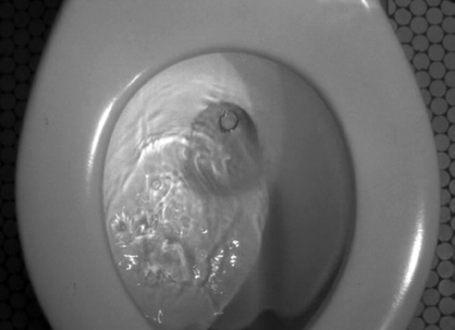
Summoning the shock of Psycho’s toilet bowl sequence, Love Walks In shows the toilet flush down a ring, as Jack rejects the advances of a ‘cougar.’
One specific allusion to Hitchcock in Jack’s monologues is a riff on the code-breaking toilet bowl sequence in Psycho. As Jack plays his piano and talks to the crowd as a voiceover, the film shows an extensive toilet sequence in flashback. Jack tells the story how he scorned the opportunity to change his circumstances and literally seize wealth when he resisted the temptations of a ‘cougar’ or older woman on the prowl for sex with a younger man. She threw her huge diamond ring in the toilet and told Jack to grab it. He flushed the toilet instead.
In Psycho Marion flushes the paper with the account of what she stole down the toilet in her hotel room. Hitchcock broke with the Motion Pictures censorship code when he showed a toilet in use for the first time on screen. He was able to hold off the censors because he convinced them that by flushing an object that was intimately connected to the film’s theme and moral dilemma, he was not indulging in prurient motives. Love Walked In is not only in dialogue with Hitchcock’s use of the toilet to describe a moment of moral reckoning, but also with his irreverent tone. The toilet scene becomes a leitmotif in the film. Throughout, both Jack and Vicky refer to it and reconsider if he should have grabbed the ring or not.
Through the emblematic story of the ring, Love Walked In presented a world of moral uncertainty. Feinmann’s novel had specified a political scenario, the early years of the Dirty War in Argentina, for this conundrum. When Campanella transferred the tale to Long Island, however, he denuded it of historical and political contextualisation. He only began to anchor a tale of moral uncertainty in Argentinean history much later when he adapted another novel for The Secret in Their Eyes.
Besides referencing Hitchcock’s toilet scene, Campanella borrows the party scene. Guillermo del Toro remarked that a party scene is standard fare for a Hitchcock film and, moreover, that Notorious’s visual aesthetics is the gold standard among Hitchcock’s party scenes. To recall, in Notorious’s most famous crane shot Hitchcock sweeps the camera down a staircase to show the key to the wine cellar in Alicia Huberman’s (Ingrid Bergman) hand. Campanella follows this Hitchcockian rule by making a party scene the climax of Love Walked In. The beach sequence that precedes the party literally gives a guide to its plot with a map on the sand. The film establishes both the predominance of a visual aesthetic and the importance of camera angles to it as in Notorious. Jack maps out the final attempt at seduction and blackmail in drawings on the sand behind their rented beach house. He fights with the private eye, who wants to give up the case, and steals his gun. The final shot of the sequence is a bird’s-eye-view of the map on the sand as the waves begin to obliterate it. It both prefigures the project’s failure and the stylistic aesthetic of low and high angles – up and down staircases, and from the tree to the balcony – in the subsequent party scene.
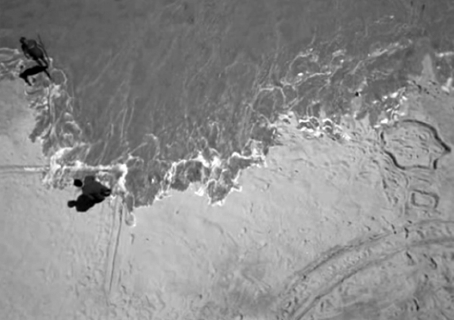
A wash out in Love Walks In: bird’s-eye-view of the map Jack (Dennis Leary) plots on the sand to show his plan for seduction and blackmail.
Making Mrs. Moore (Marj Dusay) swivel her head, Vicky (Aitana Sánchez-Gijón), wearing a short version of Ingrid Bergman’s black ball gown in Notorious, walks in on her mission to seduce Fred Moore in Love Walks In.
When Vicky makes her entrance at the party in her sparkly black dress, she recalls Ingrid Bergman, another high-cheekboned beauty in black evening attire who spoke in accented English, as Alicia Huberman in Notorious. In both cases gazes are riveted on them at a party. Fred’s wife almost dislodges her neck vertebrae as she turns to check Vicky out. Both Vicky (Marj Dusay) and Alicia were sent on missions to seduce the owners of the mansion, Fred and Sebastian (Claude Rains) respectively. The cat-and-mouse game to entice Fred up the mansion’s staircase in Love Walked In, however, pales in comparison to the spy game in the basement of Notorious. Simply put, the allusions in the party/seduction scene are not as original as the beach map. Nonetheless, Campanella’s study of classic Hollywood, and his attempt at commercial success by eliciting comparison to these films, is in evidence everywhere. In Argentina, where the original novel Ni el tiro del final had been well received, and hence where the film had a better chance of positive reception, Campanella’s film fell flat. Nonetheless it did elicit indirect comparison to Hitchcock. In a review entitled ‘Un policial que falló la puntería’ (‘A crime film that missed the target’) in La Nación Adolfo C. Martínez pronounced the film ‘regular’ (mediocre) with a wordplay that mixes references to a well-known tango lyric and Hitchcock’s moniker, ‘the master of suspense’: ‘The final result is a suspense film without any suspense. Something fatal for the genre’ (14 January 1999). Trying to be a Latin Hitchcock had not worked out.
V. THE RETURN TO ARGENTINA: CROSSOVER TRIANGULATION AND TRANSNATIONAL SUCCESS WITH A DIFFERENT GENRE
After the decidedly mixed, if not outright bad, reviews for Love Walks In, Campanella regrouped and returned to Argentina to make films in Spanish. He reconnected with Fernando Espest with whom he had co-written scripts before leaving for New York. They pulled out an old draft from that period on which to base their first new collaboration. Reassessing his commercial strategy, Campanella calculated he could better connect with his audience through a different popular genre. For his next three films, all of which were collaborations with Espest, he turned away from noir to romantic comedy. This genre change and the return to writing in his native language rekindled his sense of humour and led him to express working-class solidarity. In a sense Jack’s downbeat social class monologues from Love Walked In were put back into context, making sense as simplified Peronist politics. The resultant trilogy of films in Spanish – El mismo amor, la misma lluvia (Same Love, Same Rain, 1999), El hijo de la novia (The Son of the Bride, 2001) and Luna de Avellaneda (Avellaneda’s Moon, 2004) – established Campanella’s reputation as primarily a Latin American director and significantly blurred connections to his American apprenticeship and his work in television, through both of which Hitchcock had seeped in through osmosis.
It is a common pattern that directors who begin their careers looking to Hitchcock’s model find their own distinctive style or artistic vision mid-career. What is different about Campanella is that not only does he return again to Hitchcockian aesthetics and genre concerns later on but also that when he crossed back to Argentina his new work was repeatedly judged there as a transnational product or, worse, as a Hollywood sell-out. Since issues of national identity and globalisation framed the reception of Campanella’s romantic comedy trilogy, an analysis of these films allows us to step back and consider what constitutes critical components of national and transnational cinema, of the local and the global.
As a transnational director Campanella symbolised what Tamara Falicov calls ‘The Cinematic Tango’, the dual allegiances to Europe and Latin America manoeuvering around Hollywood:
Argentine cinema might be described as dancing a complicated tango, with the Hollywood film industry on one arm and European cinema on the other. While it is entangled with both partners, one more commercial, one more auteurist, it is a cinema that cannot be separated from its Latin American comrades, who are watching the awkward tango from the periphery of the dance floor. While it has historically aimed to distance itself from its Latin American neighbours by invoking its European immigration origin story, it cannot escape its position in world geopolitics, economic stability or geographic location … protectionist policy measures (taxes on movie tickets, low-interest film loans, subsidies, co-participation agreements and so on), even within a neoliberal environment, are unique to the Argentine situation, partly due to its position as a ‘Europeanised’ Latin American country. On the one hand, legislators and film lobbyists envision Argentina as an industrialised country with a strong state-supported culture similar to a social-democratic European country. On the other, proponents of a ‘populist’ perspective argue that Argentina should be categorised within the Latin American paradigm; it is seen as a subordinate, developing nation in need of industry protection. (2007: 5)
Over the period from 1999 to 2006 Argentina suffered one of the greatest financial crises in its history. Campanella’s popular romantic comedies, which reaffirmed family ties and community values as sustenance against the economical collapse, served as escapist fare for the local market.
VI. THE POPULIST TRILOGY, BACK TO THE TANGO
Campanella’s first box office success in Argentina and to a lesser extent abroad was Same Love, Same Rain, billed as a ‘romantic-social comedy’. The title, a verse from the tango ‘Por la vuelta’ (‘A toast to our return’) of Enrique Cadícamo, to music by José Tinelli, acknowledged the local Argentine audience.8 As Campanella observed to Lorena García of La Nación, in ‘Cine local, como de Hollywood’ (‘Local cinema, like Hollywood’s’), he took a populist perspective through his choice of everyday protagonists who lived on the margins of history:
It is somewhat the story of those who never were in anything, those who weren’t the protagonists of the history. I mean to say: those who were not the disappeared, nor the Malvinas veterans, nor those who went bankrupt with the 1050 decree. But indirectly we have all suffered. (15 September 1999)
The film tells the story of Jorge (Ricardo Darín), a short-story writer who works for a left-leaning weekly, and Laura (Soledad Villamil), a waitress. He falls in love with her when he spots her in the back seat of a taxi cab with the window open craning her neck so the rain can fall on her face. Jorge and Laura fall in and out of love over the course of the two decades beginning in 1980. Meanwhile at the newspaper Jorge’s stories are cut down, censored and dropped from regular rotation. When he attends the opening of a film that adapts another one of his stories, he leaves in horror at the lurid perversion of his work. The conflicts in the newsroom reflect the political tensions of the era. When a veteran reporter is let go, the other workers chip in to support him, but he commits suicide. Jorge (Ulises Dumont) eventually loses his job, too, but reuniting with Laura in the rain leaves him optimistic.
Same Love, Same Rain won all the major Silver Condor awards, the Oscars of Argentina, and was a breakthrough vehicle for the romantic starring duo of Villamil and Darín. When Julia Montesoro interviewed Campanella for an article in La Nación entitled ‘El mismo amor, pero un éxito sin igual’ (‘The same love, but an unequalled success’), he confessed, ‘In the US I feel like I don’t have an identity; on the other hand I find it in Argentina’ (10 October 1999). Yet some doubted that Campanella could naturally channel an Argentine identity. Guillermo Ravaschino writing for cineismo.com found the film inauthentic, by which he meant Hollywood-like:
Like some auto paint jobs Same Love, Same Rain has three layers. The meticulous excess, which is the first layer, favors naturalness. But naturalness has to serve another, very different layer, which is structured by political commonplaces and clichés of romantic cinema from the cradle of Hollywood. This layer is the most opposed to naturalness. And it becomes ever more essential, to the detriment of the other layers. http://www.cineismo.com/criticas/mismo%20amor,%20la%20misma%20lluvia,%20el.htm
Ravaschino criticised Campanella for not staying with the simple story of a youth unconcerned with politics and at the same time for simplifying the story’s political background:
Initially one would say that Jorge is just an average kid. But Campanella refused to, didn’t know how to, or didn’t feel capable of telling a story along these simple lines. Firstly he lets certain echoes of the last military dictatorship enter through the window. Since it all starts off in 1980, and not three or four years earlier, Same Love, Same Rain gives itself the luxury of being a ‘repudiation’ of the most innocuous kind: the disclosure of a raid based on what happened before, which occurs while at a restaurant. (ibid.)
Campanella responded to accusations of making ‘a comedy in the Hollywood style’ by noting a difference in his use of humour in Same Love, Same Rain:
Perhaps people say that it seems like American cinema, because in the movie there are jokes that make one laugh, there are scenes that make one emotional. People point out that it’s well made, has good photography and production values. As for content, I connect it more to Italian comedy – where the situations are not funny, but the characters act in an amusing manner – than to Hollywood comedy. Because even though funny situations happen in the comedies that Hollywood makes today, they don’t have irony or sarcasm, characteristics which are otherwise typical of Argentinean humor. (Quoted in Montesoro 1999)
Although the humour of Same Love, Same Rain was not the same as in, for example, a Julia Roberts movie, it was not that far off from the humour of Hollywood or Italian films of an earlier era. The simplification of political events was a hallmark of these films, too. It served as the stylised backdrop to Campanella’s next film, his most successful comedy, The Son of the Bride.
In The Son of the Bride the workaholic 42-year-old Ramón Belvedere (Ricardo Darín) runs an Italian family restaurant fallen on hard times at the peak of Argentina’s economic implosion. Ramón is divorced and less than attentive to his girlfriend Naty (Natalia Verbeke). His father (Héctor Alterio) wants to give his mother (Norma Aleandro), who is suffering from Alzheimer’s, the church wedding they never had. Eventually Ramón is forced to sell the restaurant business to investors and let his longtime employees go, but his parents finally have their wedding ceremony.
Any film that ends with a wedding, as this one does, is pure melodrama. There are no weddings in Hitchcock. This comedy played well internationally because of the tender family story and the social consciousness generated by the timely representation of Alzheimer’s. Campanella’s own mother was suffering from the disease at the time he wrote the film’s script. The Son of the Bride was Argentina’s Academy Award entry and was shortlisted, although it did not win. Despite the film’s popular appeal, Fernando López in his La Nación review, ‘Expertos en comedias emotivas’ (‘Experts in emotional comedies’), expressed discomfort with melodramatic simplification: ‘when it plays on the sentimental chord and gets close to melodrama, the language becomes more direct – at times it borders on sententious and overwrought – and the film pales’ (16 August 2001). Significantly, though, López goes on to praise the film by reclaiming Campanella as Argentine:9
The Son of the Bride is a very Argentine film in several ways: in the recognisable nature of the characters, in the manner in which one can see them seek a balance in the midst of the fight for survival, emotional misfortune and others’ judgements; in the exercise of a playful, caustic, and many time self-directed humour, which acts as a defensive shield to adversity; in the resigned familiarity with an abnormal situation that has already become routine; and in the diffuse and malleable limit that separates what is legal from corruption or immorality. (ibid.)
American reviewers also praised the film for its Argentinean realism, albeit again a simplification of events. Stephen Holden wrote in the New York Times that it was tempting to view Ramón’s ‘exhausting’ midlife crisis as ‘emblematic of Argentina’s precarious economic health’ (22 March 2002). However, in Argentina the film was not universally well received.
At the same moment as this populist trilogy identified Campanella as Argentine, looking from outside of Argentina in, these films alienated some Argentinean film critics, particularly those writing for El Amante, an influential Argentinean film journal, and for Cineismo, an Argentinean online cinema journal. Taking international and especially European art-house cinema for comparison they disparaged Campanella’s films as formulaic. This reaction was also pronounced for the third film in the trilogy, which was a European coproduction.
Avellaneda’s Moon, which again starred Ricardo Darín, was an Argentinean/Spanish co-production. In Spain it was nominated for the Goya for Best Hispanoamerican Film. But unlike The Son of the Bride it received little US distribution.
The film tells the story of the eponymous social club in provincial Buenos Aires that has fallen on hard times, as have its members. Ramón Maldonado (Ricardo Darín), who was born at the club on carnival night in 1959, loses his job and is separating from his wife Verónica (Silvia Kutika). She and others are looking for love on a tight budget. Their son also loses his job and plans to emigrate to Spain. When the club is fined for not filing reports over the last fifteen years, the members debate disbanding and selling the place to transform it into a casino and to take on jobs working in it. The vote to sell wins. Ramón’s son leaves for Spain.
Avellaneda’s Moon has one of the funniest, ironic representations of the perils of globalisation in all of Campanella’s films. Ramón’s wife tells him she wants a separation because their relationship lacks romance. One of the telltale signs, she explains, is that he no longer even wears cologne. Ramón stops off to buy some. Looking at the fancy packages in the store window, he first asks for the Calvin Klein cologne he used to wear, but the price is too high, so the clerk suggests a name brand Argentine cologne on the same shelf. The price is still too high. They go down the possibilities in the store; all are too expensive for Ramón. Without missing a beat in his sales pitch the clerk walks right out of the front door of the store beckoning Ramón to follow him to the ‘annex’. The store clerk seamlessly transforms into a street vendor as he stations himself beside a sidewalk display with knock-offs. He repeats the same sales pitch he gave inside, first for the Calvin Klein ‘type’ cologne, made in Taiwan – too expensive – then for the imitation of the Argentine brand – also too much money. Finally the clerk suggests rows of simple plastic bottles of a natural local ‘artisanal’ production and launches into a description of the scents. Acknowledging that he found something with a rock bottom price he can afford, Ramón sighs, ‘De paso, colaboramos’ (‘At the same time we collaborate’) – that is, they support each other and a national industry. Throughout the whole sidewalk sequence medium shots bisect the bodies in order not to show the actors’ faces, only their hands. At the end of the sequence the clerk squats down, showing visually how low the country has fallen, and puts the bottle into a cardboard box with shredded paper. Ever keeping up the sales pitch, he explains to Ramón that he has saved money because with these local products he is not paying for any marketing. In an ultimate parody of a luxury transaction the vendor inserts a small cheap soap as an gift extra. In a latter sequence, his wife and friend complain about the bad smell in the room when Ramón uses the cologne. This is situational comedy played at its best. Repetition of a paradigm generates the humour. Likewise it not-so-subtly critiques how globalisation has marginalised the average Argentine, as it depicts the lengths that Argentines had to go to survive the economic crisis.
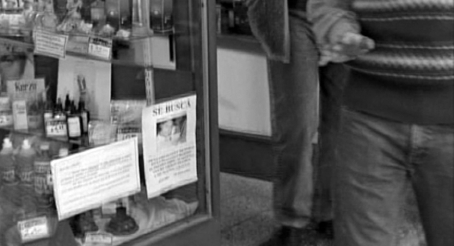
Framing for anonymity in Avellaneda’s Moon: The storekeeper guides Ramón to the ‘annex’ or the street to offer him cheaper cologne.
In Moon of Avellaneda the display of cheap imports and ‘artisanal’ brands on the sidewalk, all that Ramón can afford, shows how far down Argentines have slipped economically.
In a parody of a luxury transaction, the street vendor squats down to package the home-made cologne with an extra gift in Moon of Avellaneda.
In all three of Campanella’s Argentine romantic comedies there are similar scenes of disillusion such as the cologne sale that express social critique and working-class solidarity. Campanella recuperated a locally inflected sense of humour through this trilogy.
What is less studied than Campanella’s internationally successful film trilogy is his television work of the same period. This television work was more global, as was Hitchcock’s whose most productive period coincided with the advent of television. To clarify, Hitchcock reached a wider audience through television, for his original series and for the rebroadcasting of his films over the years, than he ever did in movie theatres. Interestingly Campanella alternated between films in Argentina and television projects in the US and Europe – eight episodes for Comedy Central in 2000 of Strangers with Candy, which fictionalised the true story of a 46-year-old drug addict who returns to the high school classroom – then in 2002/03, two episodes for NBC of Law and Order: Criminal Intent and one of Dragnet. In 2006 his crossover career inspired the theme of his television project, seven episodes of a television series Vientos de agua (Winds of Water), a Spanish/Argentinean coproduction, the first series which Campanella wrote. Wind of Water alternated between stories of a Spaniard who emigrates to Argentina in the 1930s because of the Spanish Civil War, and an Argentinean who emigrates to Spain in 2001 because of the financial collapse. Campanella himself became a Spanish citizen in 2006.
VII. A RETURN TO HITCHCOCK AND CLASSIC NARRATIVE FILM: A NEW TRIUMPH WITH THE SECRET IN THEIR EYES
In 2009, Campanella launched his most cinematographically ambitious film: The Secret in Their Eyes, an Argentinean/Spanish co-production. With this film he revisited the thriller, the generic territory of his early career while reprising the model of the love story from his populist trilogy. He enhanced the romantic connection by reuniting the same actors from Same Love, Same Rain. Even among Campanella detractors in Argentina, whose sarcastic critiques we will consider shortly, the universal opinion is that The Secret in Their Eyes is Campanella’s best film to date. Narcisco Brega opens his article in El Amante: ‘At this point now no-one, or almost no-one, would dare dispute, at least not too emphatically, that The Secret in Their Eyes is Juan José Campanella’s best movie, whatever this may mean for the person who makes that statement’ (2009: 23). The international acclaim at festivals and in award nominations for the film was loud and strong. In Spain it was nominated for nine Goyas, including the co-production duo of top categories – Best Picture, as well as Best Hispanoamerican Picture. It won the latter. Most significant for its overall international box office success, the film made the short list of five finalists for the Best Foreign Language Film Academy Award, a triumph for Campanella and a source of national pride for Argentinean cinema. Then despite being an underdog to Das weisse Band: Eine deutsche Kindergeschichte (The White Ribbon, 2009) and Un profète (The Prophet, 2009) in the competition, the film won the Oscar. Pedro Almodóvar presented the award to Campanella.
Many critics point out that The Secret in Their Eyes reflects a return to classic Hollywood filmmaking in its structure and narrative. The film tells the story of Benjamin Espósito (Ricardo Darín, again) who in retirement from his job as a judicial court clerk is writing a book inspired by an old unsolved homicide case. Over the intervening decades Espósito has kept his love intact for Irene Menéndez-Hastings (Soledad Villamil), now a judge, with whom he worked on the case.
A young married woman, Lisa Colotto (Carla Quevedo), was raped and murdered in her own home in 1974. The lack of resolution to the case has long haunted Espósito and obsessed the victim’s husband Ricardo Morales (Pablo Rago). In the aftermath of the crime, each day Morales sits in train and bus stations and watches for signs of his wife’s killer. Investigations lead not only to the pursuit, arrest and conviction of Colotto’s killer Isodoro Gómez (Javier Godino) but also the renewal of an office grudge between Espósito and Romano (Mariano Argento), a supervisor who was reprimanded for his heavy-handed tactics in the original investigation. To settle this old score Romano plots to have Gómez, a common criminal, included in an amnesty release for political prisoners. Furthermore he sets him up as an undercover assassin for the government upon his release. After a meeting in Romano’s office Espósito and Menéndez-Hastings are shocked when Gómez gets in the elevator with them and threatens them with a gun. Shortly after, three Triple A paramilitaries (members of the far-right death squad Alianza Anticomunista Argentina) break into Espósito’s house, killing Pablo Sandoval (Guillermo Francella), a good friend and coworker who is sleeping off a drunken binge there. Espósito imagines Sandoval died heroically in his place.
Many years pass. When Espósito visits Morales at his farm he discovers that Morales had kidnapped his wife’s killer after Gómez threatened Espósito. Since then Morales has kept Gómez isolated and chained in a cage in a shed. Espósito simply leaves the farm and finishes his manuscript in which he manages to admit his love for Irene. When she reads it, she also declares her affection. They pledge to make their love work.
As suggested in my own questioning of Campanella at the San Sebastián Film Festival, with which this chapter began, one key to this film’s success is that it reflects a return to Hitchcock, to what Campanella called Hitchcockian ‘osmosis’. Subsequent sections will explore these complex and far-reaching connections through close analysis of The Secret in Their Eyes in terms of the following: first, the love story or romance within the thriller; second, the balance between humour and drama especially in the manipulation of suspense; third, the multiple endings and their political, ideological and ethical implications; and fourth, the chase scene and the role of cinematographic ambition or innovation.
VIII. FROM ROMANTIC OBSESSION TO NEW BEGINNINGS: THE TEMPO OF TERROR AND ROMANCE VIA VERTIGO AND NORTH BY NORTHWEST
The Secret in Their Eyes is based on a novel by Eduardo Sacheri originally entitled La pregunta de sus ojos, then reissued with the same title as the film. Campanella and Sacheri collaborated on the script.10 Significantly, the movie greatly expands the role of Irene from that in the novel. For one, it introduces a romantic relationship between Irene Menéndez-Hastings and Benjamin Espósito. Reprising the romantic duo of the actors Ricardo Darín and Soledad Villamil recalls aspects of romantic comedy from Campanella’s earlier films. For another, the film enhances Irene’s role in the workplace, in particular making her a more active prosecutor than in the novel. In the film, Irene is a successful judge who apparently has it all – prestigious job, husband and children. Though older than she is and now retired, Benjamin on the other hand never rose higher than a clerk in the judicial office because he lacked a degree. This representation of hierarchical differences and the societal change to a more assertive role for a woman in The Secret in Their Eyes also reflects changes made from novel to film. Most of the shift in emphasis from novel to film occurs along gender lines between Irene and Benjamin’s co-worker, Pablo Sandoval. Significantly, in the novel Sandoval initiates the successful interrogation of the accused murderer, Isidoro Gómez, by baiting him with insults to his manhood. In the film Irene fills the same role and uses the same dialogue as Sandoval does in the novel. Having Irene nail the sexual predator and murderer by unmasking his insecurities affects gender revenge. Thereby the film presents a more powerful, activist image of women than the novel does. It symbolises the era of Cristina Fernández de Kirchner, President of Argentina (2007–), and that of Brenda Johnson (Kyra Sedgwick), Los Angeles Police Department Deputy Chief in The Closer (2005–2012), cable’s most widely-viewed scripted show in US television history during its run.11
These two major changes in Irene’s role, highlighting romance and police procedure or prosecution, moreover represent the genre mix of The Secret in Their Eyes. Its complex hybrid structure at times alternates and at other times combines terror and romance through subtleties of tempo and tone. By appreciating this hybrid structure, a departure from Campanella’s trilogy of romantic comedies, we can see how Campanella returned to Hitchcock, for Hitchcock achieved a similar balance in his mature period in films such as Vertigo and North by Northwest. Some critics have seen this balance as one of the most important characteristics of his aesthetics throughout his career. As Truffaut wrote, ‘It was impossible not to see that the love scenes were filmed like murder scenes, and the murder scenes like love scenes’ (1984: 345).
Extreme close-up of Irene’s (Soledad Villamil) eyes in the credit sequence sets a romantic tone to The Secret in Their Eyes.
The Secret in Their Eyes opens with close-up shots of eyes, both of Irene and of Benjamin, that both establish a leitmotif and recall Vertigo’s credit sequence. Both films tell the story of a man’s lifelong obsession with a woman. They are fundamentally love stories. The film’s misty eyes set a more romantic tone than did Vertigo’s threatening eye that turns red in Saul Bass’s vision. A similar change in tone to red, which implies a frightening loss of control, however, occurs in The Secret in Their Eyes in an early flashback to the murder scene. The spectator is forced to confront a full-screen image of Liliana Colotto’s (Carla Quevedo) nude body, bloody and bruised, sprawled across the floor, limbs out-stretched, eyes wide open. In both films images of eyes as leitmotifs signify alternately romance, then terror.
Nonetheless, Hitchcock’s presence in The Secret in Their Eyes is less a matter of direct citations, such as we have suggested with regard to the Vertigo credit sequence, than a more indirect appreciation of the complexity of classical cinematographic structure and melded genres, in this case one that combines romance and terror, which Vertigo epitomises. In short, the classical composition of The Secret in Their Eyes owes its cinematic heritage to Vertigo. Both are rooted in music. Bernard Herrmann’s score for Vertigo was profoundly influential. Jack Sullivan in Hitchcock’s Music characterises it thus: ‘More than any cinema music, [Vertigo’s score] enacts the despair and stubborn persistence of our attempts to re-create the past’ (2006: 234). Likewise in his article ‘Pretérito Imperfecto Futuro Perfecto’ (‘Preterite Imperfect Future Perfect’) in El amante Gustavo Noriega points to the obsession with memories and their uncertain character in The Secret in Their Eyes as a principal strength of the film:
The memories that appear in the movie, in the form of flashbacks, often turn out to be false (the execution carried out by Morales), exaggerated (the farewell in the train station) or pure suppositions (the final heroic gesture of Sandoval). The anchoring of the movie to the past is neither firm nor indisputable. To this common aspect of all police procedurals – uncertainty regarding what happened with respect to a specific crime – Campanella adds layers of ambiguity that transcend the genre and take on wider implications. (2009: 16)
Given this manipulation of time, Noriega concludes, ‘the impact of The Secret in Their Eyes is global’ (2009: 17). Even without directly comparing the scores of Vertigo and The Secret in their Eyes and how they specifically enhance the films’ structures, we can note the importance and appreciation for classical musical composition in the two directors. Sullivan documents Hitchcock’s collaboration with Herrmann and the latter’s musical sources of inspiration.12 To prepare for shooting The Secret in their Eyes Campanella studied audiotapes of Beethoven’s ‘Moonlight Sonata’. He claims the structure of the third movement – ‘the tonic and the dominant with modulating bridges’ – inspired the film’s structure of two themes, based on the love story and the police story:
I tried to make sure that we wouldn’t be changing tempo and theme at the same time. When we switched from one narrative to another, we were still in the same energy. We would only change the energy within one theme. We had to find all these bridges to modulate from one narrative to another easily, to flow in and out of all the themes: starting with theme one, theme two, then back again to theme one, theme two, and then the development of the coda; the end where everything gets mixed up. We worked with that sonata structure in mind. I became obsessed.13
This emphasis on music as a source of film structure in order to control changes in tempo and theme between romance and thriller looks back to Hitchcock and forward to new beginnings.
To give one specific example of film structure as a musical composition, or as a study of tone and tempo, it is revealing to compare the endings of North by Northwest and The Secret in their Eyes. To recall, North by Northwest ends with the famous cut to a tunnel sequence to signify the lovemaking. Similarly The Secret in Their Eyes ends reimagining the encounter on the train platform between Irene and Benjamin. These two romantic endings signify new beginnings. However, they are also in stark contrast to the resolution of the respective thriller plots. In North by Northwest the climactic confrontation happens at the Russians’ house; in The Secret in Their Eyes, at Morales’ farm. Both are isolated locales. Between the climactic scenes there is another that modulates the tension, changes the tempo and tone. In North by Northwest the main characters depart from an airport, an emblematically classic transition. In The Secret in Their Eyes Benjamin Espósito visits Pablo Sandoval’s grave. Campanella discusses how he came upon this bridge in musical terms:
I didn’t want to end everything with question marks, even though I wanted to leave it to the audience to decide whether Espósito tells on Morales or not. That’s actually what audiences in Argentina are going crazy about. They argue, ‘Is Campanella supporting vigilante justice?’ I knew that was an answer I didn’t want to provide in the movie; but, I wanted to provide at least one answer and I wanted to end the last story, the love story, and come back to the home key. When we started writing the script, I knew we couldn’t go from the scene with the cage – which, hopefully, if it worked, would be a strong dramatic scene – to the next scene where Espósito professes his love to Irene. I needed a little bit of time for the audience to make the transition and that’s when we came up with the idea of Espósito taking flowers to the grave of his friend Sandoval. It was related to the case because Sandoval was killed during the case; but it was also related to the love story. Sandoval is associated with both stories. That scene served as a bridge and perhaps also contributed to the feeling of yet another ending. I can understand the criticism that the film has too many endings, but it was the best of the possibilities I had to work with. (Quoted in Guillen 2009)
Like North by Northwest, Hitchcock’s great chase movie, The Secret in Their Eyes does not end with the solution to the crime, or even with the restitution of justice for the sad ‘wrong man’, the husband Ricardo Morales. As we have seen in the above quote, Campanella chose to leave these aspects of the plot open-ended. Morales still could be his wife’s killer. Espósito may or may not report Morales’ kidnapping and incarceration of Gómez. As in North by Northwest, the film ends reestablishing the balance between comedy and thriller. Espósito puts a flower on Sandoval’s cemetery niche, then the film cuts to Espósito deciphering his midnight note of ‘Temo’ (‘I am afraid’), by adding the missing letter ‘a’ to make ‘Te amo’ (‘I love you’). In a final make-over, so to speak, since Espósito had not dared to express his love before, a newly confident Espósito strides into Irene’s office. When the film cuts to the close-up of her smiling face, as she says ‘It’ll be complicated’, the final balance between thriller and romance is reached. It is as satisfactory a final resolution as the kiss and suggestive tunnel shot at the end of North by Northwest.
Richard Allen calls this type of ending in Hitchcock’s comic thrillers like North by Northwest a ‘romantic renewal’. He explains: ‘Hitchcock, the godlike narrator, orchestrates a self-evidently fictive universe to yield blessings upon its hero and heroine, come what may, and the anarchic force of human sexuality serves only to fuel rather than to undermine romantic renewal’ (2007: 13). This idea of romantic renewal modeled on Hitchcock in The Secret in Their Eyes led to allegorical readings, and biting criticisms of the film, which we will consider in a subsequent section.
IX. BANKING ON HUMOUR, MASTERING SUSPENSE
At San Sebastián when Campanella acknowledged the presence of Hitchcockian ‘osmosis’ in his films he highlighted the balance between humour and drama. In The Secret in Their Eyes ironic humour plays against the meshed genres of romance and political thriller. Particularly in sequences with Pablo Sandoval, played by Guillermo Francella, a well-known comic actor in Argentinean television, humour is interjected to balance tension and achieve suspense, the trait most closely associated with Hitchcock.
Early in the film, the crime investigation unfolds through a series of wrong accusations. Romano manufactures trumped-up charges against two immigrant labourers, who are beaten into confessing to the murder in order to close the case. Espósito storms into the jail, unmasks the sham and frees them. Back at headquarters he denounces Romano for the travesty of the false arrests and launches into a public brawl with him in the corridor. In the heat of the moment Romano makes a final verbal threat, ‘You don’t know who you’re dealing with. You don’t have the slightest idea.’ The sequence cuts leaving the words suspended in the minds of the spectators and giving them greater importance as a premonition. The tension is typical of a political thriller. At this moment the threat is left out there for Espósito who has bettered his rival. The verbal warning likewise invites the audience to watch Espósito’s back, so to speak. Romano affects his revenge much later in the film, and much more perversely, when he releases the actual murderer to allow him to be useful as an undercover assassin for the military government during the Dirty War. However, before reaching this political climax and settling of scores, the film plays with an alternation of humour and terror.
After Romano’s threat, the film cuts to one of many humourous scenes, deploying as much physical as verbal humour, with Espósito’s co-worker, the office clerk Sandoval. Serving as comic relief in The Secret in Their Eyes, Sandoval answers the office phone with inventive zingers, such as ‘Blood Bank’, ‘Tactical Revolutionary Command’ or ‘Sperm Bank, Loan Department’. Almost all of his dialogue, and the repartee he generates in the film reflects a particularly Argentinean tendency to sarcasm and dark humour. In an article entitled ‘Poné a Francella’ (‘Send In Francella’) Nazareno Brega applauds the depth of the performance of Guillermo Francella: ‘Francella adds mischievousness to his character and takes away the sense of resignation’ (2009: 23). To give one example of Sandoval’s dark humour, when his new female boss Irene walks into the office in a black dress, Sandoval compliments her: ‘A saint has died today. Because an angel’s dressed in mourning.’ She acknowledges his remark and rejoins: ‘It’s a method we angels have to lose five pounds.’ After Irene closes her office door, Espósito laments that he cannot come up with such quick ‘piropos’ (‘flirtatious compliments’) although we have already heard him spew out a half dozen of them to every woman he passed as he entered the building at the beginning of the day. To which Sandoval knowingly replies: ‘It’s easier for me. I’m not in love.’
Like Hitchcock, Campanella masters suspense in The Secret in Their Eyes by alleviating the tension through humorous interjections. In their resurrected investigation Espósito and Sandoval drive out to the provincial city of Chivilcoy to break into the house of the mother of the suspected criminal Isidoro Gómez and find clues to his whereabouts. As the sequence begins, the duo is filmed from behind sitting in the car on the stakeout. Sandoval breaks the tension with comic banter, as he complains he has to pee and that Espósito has seen too much Perry Mason. Once in the house the camera follows Espósito from behind as he searches each room, increasing the tension. He finds Gómez’s letters in a drawer and sits down to read them. Framed in mid-body only, Sandoval enters the room, approaches Espósito in the foreground from behind and lays his hand on Espósito’s shoulder. The gesture, which is repeated in several subsequent scenes, startles him and the viewer, which leads to a funny verbal exchange. Sandoval takes the letters from Espósito to look them over. While the latter sets off to check for envelopes in the trash, Sandoval tucks the pack of letters in his coat rather than returning them to the drawer. Their search in the waste bins is cause for visual humour until they pause to listen for the old woman coming home and then hide from her. A low-angle shot of the woman’s dog chasing them out of the house ends the sequence with yet another comic touch.
A subsequent sequence, a flashback that imagines Sandoval’s death, represents another example of how Campanella develops a scene visually through a shift in the balance between comedy and thriller. This instance adds depth to the film’s message since it derives its force from the political context of the Dirty War. Espósito has rescued Sandoval for the umpteenth time in a drunken stupor and taken him to his own home because his wife refuses to take him in. The scene begins by reprising Sandoval’s role as a comic foil to Espósito. The classic situation of a drunken man being taken home plays out in dialogue and physical comedy. However, when Espósito steps out for a moment, three burly men burst into the house. They are backlit by stripes of light from the side, like ////, which William Rothman has identified as a classic Hitchcockian motif.14 The darkness of the room symbolises the danger.
In a subtle heroic visual gesture, with the intruders at the doorway, Sandoval turns a photograph of Espósito over on the table. It is a tribute to Hitchcock’s style that the film respects the audience to interpret a visual clue to understand one of the most frightening realities of 1970s Argentina: the extralegal assaults of various paramilitary groups during the Dirty War, mostly sanctioned by the military government. In the film, Sandoval’s gesture encourages viewers to interpret the visual cues. The photograph would give the secret police an image of what Espósito looks like. Sandoval knows the score: these men have come to ‘disappear’ Espósito. When men ask ‘Are you Espósito?’, Sandoval answers ‘Yes, I am.’ As in classic Hitchcock, the audience is kept in the know. The film cuts. When Espósito returns to his house, he finds the bloody corpse of Sandoval. He knows, and the audience knows, through the repetition of the clue of the overturned photo, that Sandoval allowed himself to be mistaken for Espósito.
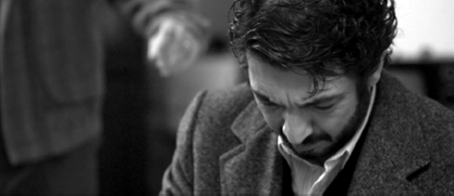
Leitmotif of suspense: anonymous as framed in mid-body, Sandoval scares Espósito when he puts his hand on his shoulder from behind in The Secret in Their Eyes.
A comic exit in The Secret in Their Eyes: Gómez’ mother’s dog chases Espósito out the door.
The search scene in Chivilcoy is only one of many similar scenes in The Secret in Their Eyes that typify a television police procedural, a genre in which Campanella has achieved considerable success in the US. To recall, from 2000 to 2010 he directed seventeen episodes of Law and Order: Special Victims Unit, a series that focuses on sexual crimes. Audiences can generally follow police drama scenes without any special understanding of the historical or political context. However, other important scenes in The Secret in Their Eyes that also show the influence of Hitchcock’s aesthetics, such as the flashback to Sandoval’s death, depend on a more local understanding of the political and historical context. These scenes have generated a polemical debate in Argentina about the moral stance of the film.
The //// Hitchcockian motif marks the Triple A paramilitaries who come to assassinate Espósito, but kill Sandoval.
X. HISTORICAL REVISION WITH A ‘FALSE NOTE’?: CAUGHT IN THE ELEVATOR OF NORTH BY NORTHWEST
Consider the situation in a thriller of an elevator full of people. First a pair of good guys get on the elevator to escape the pursuit of the bad guys but the bad guys muscle in and catch the same elevator. Tension mounts, but nothing will happen in the elevator itself because there is an unwritten code of polite conduct and public behaviour in such a space. North by Northwest plays this situation for comic effect. Accompanied by his ditzy yet domineering mother (Jessie Royce Landis), Roger Thornhill (Cary Grant), who is being mistaken for the spy George Kaplan, tries to escape the bad guys in a hotel. Just when Thornhill and his mother get in an elevator, the goons jump out of another elevator on the floor and join them in the same one. Breaking the tension, mother blurts out: ‘You gentleman are not trying to kill my son, are you?’ Sequentially everyone in the elevator bursts out laughing. The film cuts to multiple reaction shots of the heavies and the other passengers laughing at mother’s irrational suggestion until she laughs along, too. Grant’s own visage communicates incredulity. Keeping up the politesse and following upon the good manners of his mother when they reach the lobby Thornhill gallantly proclaims ‘Ladies first’ and makes the goons wait for the women to exit. He runs out with the women. According to Ernest Lehman, North by Northwest’s screenwriter, Cary Grant questioned Hitch’s direction in the scene.15 He did not believe the situation worked, or that the audience would buy into the plausibility of the bad guys playing along with the public code of conduct. But despite Grant’s reservations most viewers enjoy the ride and mother’s banter even more so.
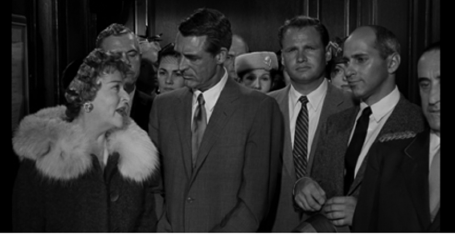
In North by Northwest mother (Jessie Royce Landis) protects her son (Cary Grant) and challenges the social etiquette of the elevator.
Low angle, big gun: In The Secret in Their Eyes Gómez gets in the elevator with Irene and Espósito and shows his power.
The Secret in Their Eyes recalls the thriller situation of North by Northwest’s elevator sequence. Irene and Espósito are shocked when the assassin Gómez gets in the same elevator with them. They instantly recognise each other. Packed together, the smartly groomed Gómez openly plays with his gun. The low-angle shot shows how he and his gun loom large in the foreground.
Gómez’s brazen gesture shows that he is now in a position to take them out at any moment with impunity. However, unlike in Hitchcock’s comic thriller where mother names the threat at hand and breaks the tension, no one speaks in the elevator in The Secret in Their Eyes. But like Grant, Campanella had doubts over whether the scene, precisely because of this silence, would work or not:
The scene that plays powerfully in Argentina is the elevator scene where Gómez has evaded punishment and threatens Irene and Espósito. Thank God it works because – when I was editing it – I was doubtful: ‘Does this work?’ But it did work because it represents a society that has shut up and shut down; a society that has accepted fear. That’s why I chose to set the movie in the pre-dictatorship days rather than during the dictatorship because everyone in those pre-dictatorship days were [sic.] already succumbing to fear by refusing to talk about it. I wanted to show that moment where they make the choice of shutting up, looking away, and running away. (Quoted in Guillén 2009)
For most viewers outside of Argentina the elevator scene only plays as thriller, as a dramatic counterpart to Hitchcock’s comic situation. The glances emphasise the leitmotif of eyes. However, as we see in the above quote from an interview at the Toronto Film Festival, Campanella intended a political message for his elevator sequence. In a historical revision that opens up the pre-dictatorship years to scrutiny he accuses Argentineans, and especially the Argentinean justice system, as represented by Irene whose eyes are downcast in the elevator, of not speaking up to denounce the rise of the paramilitaries in the early 1970s. Considering how Hitchcock dealt with an elevator sequence in a thriller reveals the significance not just of the visual leitmotif, but more importantly of the aural, of the role of silence.
Although he praises Campanella’s reinterpretation of Argentinean history overall, the critic Gustavo Noriega, witing in El Amante, faults how the historical revision and Campanella’s accusatory writing are woven into the movie’s timeline, especially in the scene in Romano’s office that precedes the elevator confrontation:
A scene in the ministry, probable den of the Triple A, gives rise to one of the few false notes of the film. Irene and Espósito go to see an ex-police officer, now a government functionary, to reproach him for having liberated the killer of Morales’ wife. In the discussion, which becomes more direct and threatening with each exchange, he answers their shouts by saying: ‘You don’t know the country that’s coming.’ In the context of the film it is a false note that only makes sense retrospectively. The reference warning of the Dictatorship stands out and appears as a concession to a commonplace within a movie that is very rigorous about its historical references. (2009: 17)
Noriega calls Romano’s warning to Irene and Benjamin an anachronistic error since Romano cannot have known a priori that Argentina would become a military dictatorship. This critique is excessively harsh. The comment is a prediction that the film moreover puts into a specific historical context. In the background of the previous three sequences a news programme plays on television that shows Gómez guarding Isabel Perón at a public rally. This media background shows not only that Gómez is a free man but also that he is now a paid assassin for the government. This foreshadows the actions of a dictatorship and reinforces Romano’s prediction. The specificity of the newsreel with Isabel Perón (President of Argentina, 1974–1976), whose political role few viewers outside of Argentina would know, makes the scene more than a commonplace view of Argentinean politics.
Gómez (Javier Godino) inserted into TV history next to President Isabel Perón in The Secret in Their Eyes.
Shifting the historical and political timeframe of the film to 1974, rather than 1968 as in the novel, made possible an important act of historical and political revision. Campanella unmasked how the societal attitudes that marked the bleak period of the Dictatorship were already forming several years earlier than is generally credited. This historical revision connected the film not only with the local Argentinean context, still processing revelations from the Proceso, but also with the global context that expected Latin American cinema to be social political discourse, particularly about the Dirty War. The success of Luis Puenzo’s La historia oficial (The Official Story, 1985), which won the Best Foreign Language Film Academy Award, set this pattern placing expectations and limitations on subsequent filmmakers to include and exploit the topic of the Dirty War in order to launch their projects internationally. Campanella’s The Secret in Their Eyes speaks to the model, but also more importantly shifts the discourse to address more nuanced and polemical contemporary concerns.
XI. THE POLEMICS AROUND MULTIPLE ENDINGS: FROM THE HERMETIC WORLD OF SHADOW OF A DOUBT TO THE FALSE FLASHBACK OF STAGE FRIGHT
Although the interpretation of the elevator and ministry sequences provoked some controversy, it was nothing compared to the hue and cry surrounding the film’s multiple endings. To recall in brief, there are four ‘endings’ that appear in the following order: first, a false flashback to Morales killing Gómez by putting him in the trunk of his car and shooting through the lid; second, a climactic scene where Morales attends to Gómez in a cage and is discovered by Espósito; third, Espósito’s visit to Sandoval’s grave; and finally Benjamin and Irene’s declaration of their romantic commitment to each other. These endings were criticised on aesthetic, political and ethical grounds. The critic Eduardo Rojas in an article ‘Espejos del alma’ (‘Mirrors of the soul’) in El Amante led the charge by accusing Campanella of being formulaic – ‘why use the still unhealed wounds of our recent history as a simple guessing game?’ Rojas questioned the film’s historical validity and lamented the political effects of aesthetic choices – ‘Why do movies insist on vindicating private vengeance to the detriment of the claims of victims and family members? Why invent a story that contradicts the presence of those claims?’ To understand Rojas’ comments and the major controversy over the film’s endings it helps to return to how the film radically changed the book’s ending. Then we will explore how Hitchcock’s films problematised the interface between aesthetics and moral and ethical issues in ways similar to The Secret in Their Eyes: first, in terms of cinematographic closure in Shadow of a Doubt, and second, in terms of the false flashback in Stage Fright. The debates in Hitchcock criticism suggest an important cinematographic context.
The film substantially alters the book’s ending to emphasise the participation of the viewer in constructing the story. In the book, a dying Morales writes a letter to Espósito asking him to carry out final requests in a visit to his farm. When Espósito arrives, he finds Morales already dead from a self-injected overdose. Exploring the farm he discovers the assassin Gómez dead, too, in an isolated building where Morales had jailed him for many years and intuits that Morales lured him out there to cover up the evidence of the kidnapping and murder. Espósito buries Gómez’s body and calls the police to report Morales’ death. In the film, the climatic ending at Morales’ farm is completely different. Espósito discovers Morales’ secret jail with Gómez still in it alive. Espósito silently acknowledges the situation and leaves it as it is. The scene is tonally golden and the light is grainy as if dust were floating in the air. The mise-en-scène communicates the sense of a period piece, of years having gone by. As the camera pans over the jail cell with its jailer and prisoner from the point of view of Espósito, the film acknowledges and may implicitly sanction Morales’ personal sense of justice. At that moment Espósito, and the viewer, are complicit to the crimes. In the novel Espósito hides evidence of the kidnapping and murder of Gómez to preserve Morales’ reputation in the provincial town, but he participates in other normal police procedures, even when the police themselves raise suspicions about Morales’ odd storage barn. In contrast the film establishes a hermetic system of justice removed from normal police channels.
This manipulation of the narrative to acknowledge a different set of circumstances and an independent or hermetic sense of justice recalls the ending of Shadow of a Doubt in the sequence of Uncle Charlie’s funeral. Uncle Charlie is being set to rest in a religious ceremony inside the church without ever having been publically unmasked as a killer. Outside of the church his niece Charlie, who has just survived Uncle Charlie’s attempt to kill her on the train, says to Jack, Charlie’s police detective friend: ‘I couldn’t have faced it without someone who knew.’ The dialogue and the mise-en-scène privilege the position of the viewer and give her access to a closed system with its own satisfying sense of justice. The Secret in Their Eyes replicates Hitchcock’s aesthetics and moral view when Espósito walks away from Morales’ house just as the niece Charlie in Shadow of a Doubt stays outside of her uncle’s funeral in the church. These films represent a closed system in which the viewer has privileged access to a subjective ethical code. The critic Rojas faults Campanella’s lack of cinematographic ambition and describes the film’s characterisations as ahistorical, Manichean reductionism:
Why stereotype the good and the bad guys outside of their historical context? As to the latter, Romano is a genetically configured bastard; Espósito, the good guy, has a sense of justice that exceeds his will. Where did this atypical Argentinean dude come from? And why does he then betray his own nature by ultimately becoming an accomplice to the private vengeance of Morales? (2009: 21)
To say the least Rojas likes rhetorical questions, which are by nature openended and leave their barbs floating in the air. His mocking comments, such as asking where this lone ranger came from, that imply that Campanella does not know the national character, illustrate the almost vindictive nature of some criticism of Campanella in El Amante. Although Rojas concludes that Espósito acquiesces to the justice of Morales’ private vengeance, Campanella intended to leave the audience not knowing if Espósito ever reveals what he knows about Morales as Gómez’s jailer. Visiting Sandoval’s grave, another one of the endings, is in musical terms, the bridge between the two themes. The multiple endings do have the effect of leaving the public resolution of Morales’ case unresolved. In this Campanella follows Hitchcock’s model in Shadow of a Doubt, Suspicion and Rebecca.
It is important now to consider a different cinematographic ‘error’, the false flashback, that Hitchcock and Campanella both exploited with some regrets because it breaks the film’s continuity, an unwritten bond of trust with the audience. The false flashback that is only corrected in the ending made Stage Fright one of Hitchcock’s most controversial films especially among French critics. Even when he spoke with Truffaut, Hitchcock doubted the wisdom of having duped the audience. Hitchcock remarks, ‘I did one thing in that picture that I never should have done; I put in a flashback that was a lie’ (Truffaut 1984: 189). To recall, at the beginning of Stage Fright Jonathan Cooper (Richard Todd) unburdens himself of the story of the murder of the husband of Charlotte Inwood, a famous actress (played by Marlene Dietrich), to Eve Gill (Jane Wyman), who is in love with Jonathan, as she speeds their car along a highway. The whole scenario, in which he implicates Charlotte for the murder and frames himself only as participating in a cover-up, is presented as a flashback from Jonathan’s point of view. The false flashback begins with a dissolve that takes us to the realm of Jonathan’s memory. The error of the flashback is only revealed through the secret of the protagonists’ eyes at the end of Stage Fright. Eve and Jonathan are cowering together in the theatre’s basement to avoid the police. As he retells the story of the murder of Charlotte’s husband, and admits to the crime, Jonathan literally transforms his face into that of a killer before her loving eyes. Jonathan then speculates that if he kills her, too, he will go free since ‘It’ll be a clear case of insanity.’ The sequence shows this transformation in a shot/reverse-shot in which only their eyes are lit against extreme shadows.
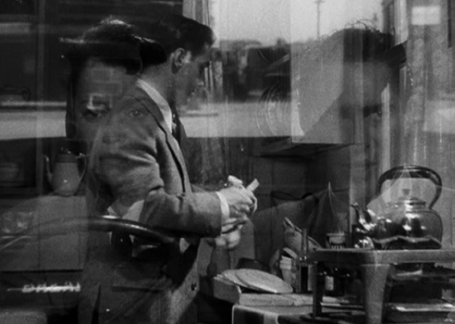
The dissolve in Stage Fright from the point of view of Jonathan (Richard Todd) that begins the false flashback/car scene to reveal he was only an accomplice to the murder of Charlotte’s husband (Marlene Dietrich).
The story in the eyes: in the basement under the stage Eve (Jane Wyman) now sees Jonathan as a murderer and reacts with horror in Stage Fright.
Reverse shot: Jonathan’s (Richard Todd expressionistically lit eyes capture his madness as he contemplates killing again in Stage Fright.
Campanella likewise employs the technique of a false flashback in the dénouement of The Secret in Their Eyes. Espósito visits Ricardo Morales’ farm in the country; Morales tells Espósito that he kidnapped and killed Gómez. The film cuts to show Morales shoot through the lid of a car trunk, where we assume Gómez lies. Espósito leaves the house but then returns again to discover that Morales is keeping Gómez alive in a cage in the farm’s shed. The viewer is left with a sense of moral justice achieved outside of the usual channels. Espósito will keep the secret and not go to the police. The narrative construction as a closed system that privileges the spectator recalls many Hitchcock films – Rebecca, Suspicion and Shadow of a Doubt, among others.
In the one ending of The Secret in Their Eyes concerning Gómez’s incarceration Campanella respects the spectator and obeys Hitchcock’s major cinematographic law: always think about the audience. Nonetheless another of the endings of the film is a false flashback. This technique violates that dictum.
Like Hitchcock, Campanella had some doubts about his own choice of a false flashback. Although he recognises it as ‘a lousy end’, he defends his choice by referring not to Stage Fright but to manipulating the language, or the music, of suspense:
The dramatic climax is the scene with the cage. I had two challenges there. In order for the scene with the cage to be surprising, for it to totally work, it had to be based on Morales and his stated assertion that he did not believe in the death penalty. When he tells Espósito the story about how he killed Gómez in the trunk of the car, that had to play as the climax of the movie. If it wasn’t played as the climax with the swelling music and the whole thing, then as an audience you would have an inner feeling that something was missing, like there’s one more beat, and you’re going to start looking for that beat. So that scene has to play like it’s the end of the movie. A lousy end, a very obvious end, but I don’t mind for a second that you think that it’s a bad ending; it has to feel like the ending. So that comes at the price of already having one ending that is not the real ending, you know? But I feel that was an appropriate price to pay for the surprise of the dramatic ending of the scene with the cage. (Quoted in Guillen 2009)
In The Secret in Their Eyes Campanella reduces the length of time that the audience is left deceived in comparison to the prolonged or ‘indirect’ continuance of the lie in Stage Fright. Truffaut even tries to get Hitchcock to agree that Jonathan lied three times. Hitchcock replies bluntly, ‘I agree the whole thing was very indirect’ (Truffaut 1984: 190). Their self-reflexive critiques show how deeply they thought about their audience at every stage of filmmaking.
XII. CUT TO THE CHASE, OR SOME FINAL REMARKS ON COMMERCIAL SUCCESS AND MOTHER’S MACGUFFIN
Campanella won the 2010 Academy Award for Best Foreign Language Film over Germany’s heavily favoured The White Ribbon and France’s The Prophet. This second Oscar nomination was the charm for Campanella. For the first time the field included two ‘thankful to be nominated’ South American films, The Secret in Their Eyes and Peru’s La teta asustada (Milk of Sorrow). Campanella interpreted his win as ‘shattering preconceptions’ about South American films for this category, which European films have dominated. Like Fernando Trueba thanking his ‘God’ Billy Wilder when he accepted his Academy Award for Belle Epoque in 1994, Campanella managed one good joke in his speech: ‘I want to thank the Academy for not considering Na’vi a foreign language.’ Both Trueba and Campanella acknowledged the significance of Hollywood in their minute of fame, but Campanella, in his ironic wink to Avatar (2009), underscored Hollywood’s commercial and ideological dominance. What commercial success means to Campanella, and for the interpretation of his films, has been controversial for a long time, as it was for Hitchcock.
‘The chase,’ Hitchcock explained in a 1951 New York Times interview, ‘makes up about 60 per cent of the construction of all movie plots – even Hamlet’ (quoted in McGilligan 2003: 311). Showing a Hitchcockian appreciation of visual innovation and plot construction, the chase scene at the Huracán soccer stadium is fittingly the piece de resistance of The Secret in Their Eyes. Campanella’s scene gives the impression of being one continuous shot as Espósito and Sandoval run after the assassin Gómez. The editing, done by Campanella himself, masterfully hides the multitudinous cuts from swooping helicopter shots, crowd pans, and point-of-view chase shots.
The relationship with mother is what brought soccer into the film. To recall, Pablo Sandoval breaks the code of Gómez’s letters to his mother, which they stole from her house in Chivilcoy, when he realises that all the names mentioned in them are soccer players. Sandoval calls on the help of his bar buddy, alias the Notary, who spews out soccer history like a computer, to tell Espósito what each of the players mentioned in the letters are famous for. This tour de force at the bar supports Sandoval’s observation that the one thing a guy can’t change in his life is his passion. (Sandoval’s passion is hanging out at the bar and getting drunk with friends; Espósito’s passion is to secretly love Irene.) Sandoval convinces Espósito that Gómez will have altered his travel routine and workplace to evade them, but because he can’t change his ‘passion’ the one place where they can find Gómez is at a soccer game. Hence Sandoval and Espósito set off to chase him down at the Huracán soccer stadium.
Hitchock enters into the discussion of Gómez’s letters to mother, too, for it is through a comparison to Hitchcock that Eduardo Rojas, writing in El Amante, criticises Campanella’s control of narrative. Rojas blasts Campanella’s representation of mother, specifically in comparison to Hitchcock’s in Psycho, as ridiculously forced and academic, neither sufficiently intimate nor sufficiently political:
Incidentally, the whole soccer subplot that serves to lead into the famous scene is bogus in its very conception: a textbook psychopath (ask Castagna: perhaps, unavoidably at this moment due to their long suffering, every Racing fan is a psychopathic individual) communicating with his mother, the sweet little old woman, in soccer code. Do you imagine Norman Bates conversing lovingly with his mother over baseball? I don’t. (2009)
For Rojas, for whom Hitchcock is a constant referent, Campanella uses soccer, ‘the opium of the masses’, to reach a commercial common denominator. Rojas forgets that the letters to mother function as a MacGuffin. They have neither intrinsic value nor deeper psychological interpretation. They serve to advance the plot, to get to the chase.
Nowadays in the Spanish-speaking world Campanella is called ‘industrial’ – that is, a commercial director, as opposed to either an independent director or art-house director.16 He achieved this status by treading in Hitchcock’s footsteps – crossing the boundary of sexual violence in The Boy Who Cried Bitch, learning television filming techniques in cable series, alternating work in his home country and the US, finding the right leading man for his aesthetics in Ricardo Darín, and most importantly achieving a balance of humour and thriller/drama, a sophisticated mix of genres, that is portrayed with techniques found in Hitchcock’s films, with The Secret in Their Eyes. Perhaps not surprisingly Campanella’s status as an auteur continues to provoke controversy in Argentina as seen in the discussion of the September 2009 issue of the Argentinean film magazine Amante de cine. The discussion continues to play out in extensive blog exchanges. Diego Batlle, a frequent critic for La Nación, decried the editorial policy of El Amante as frankly anti-Campanella. In general La Nación’s coverage of The Secret in Their Eyes’ international success has been universally positive. Adolfo C. Martínez’s review ‘Juego de mentiras, verdades y secretos’ (‘Play of lies, truths and secrets’) in La Nación predicted the controversy described in this chapter: ‘The Secret in Their Eyes is a film which doubtless will give us a lot of good things to talk about, a work that overall makes national cinema proud’ (13 August 2009). Campanella’s career continues to be reassessed.
XIII. EPILOGUE AND A REPRISE OF A NATIONAL IDENTITY IN METEGOL
‘No puede cambiar de pasión.’ (‘He can’t change his passion.’)
– Pablo Sandoval
Campanella truly never let go of the MacGuffin from The Secret in Their Eyes, the obsession for soccer. In 2013 working again with the writer Eduardo Sacheri, Campanella adapted the short story ‘Memorias de un wing derecho’ (‘Memories of a right wing’) by Roberto Fontanarrosa (1944–2007), an Argentinean icon for his cartoons, graphic novels and short fiction, for an animated movie Metegol (Underdogs), called Futbolín in Spain. Like Toy Story (1995) or The Lego Movie (2014), Underdogs brings to life the figures of a foosball table in a town’s bar to help a young boy, Amadeo, who has loved them obsessively. Amadeo’s hometown is being taken over and modernised by Grosso, a soccer media star. The grown-up Amadeo takes control of his loyal foosball team, a group of underdogs, to play a revenge soccer match against Grosso and his team, the professionals. The foosball figures are lead by Capi, the right winger of Fontarrosa’s story.
With a budget of over $20 million, Underdogs was in 2013 the most expensive animated movie ever made either in Argentina or in Spain, the two countries of the co-production.17 The film, whose opening was well timed to coincide with the lead-up to the 2014 World Cup in Brazil, was a huge box office and critical success worldwide, although its opening in the US has been delayed until 2015. In 2014 Underdogs won the Goya for best animated film, the Motion Picture Association of Argentina Awards for best adapted screenplay, sound and original score, and the Platino (Ibero-American awards begun in 2014 in Panama) for best animated film and original score.
The initial success of Underdogs positioned Campanella as a commercial or popular auteur whose global filmic circuit is constructed outside of the US, and especially in Spanish-speaking countries. Many reviews carried subheadings such as that of Pablo Scholz in El Clarín, ‘El film no tiene nada que envidiarle a Hollywood’ (‘The film has nothing to envy Hollywood for’) that invite a David and Goliath comparison.
When Diego Batlle, frequent critic for La Nación, reviewed the movie for Otroscines.com, he pointed out not only that Campanella’s author’s ‘spirit’ comes across clearly in Underdogs, but also that this nostalgic ‘spirit’ continues to be problematic in Argentina:
If Avellaneda’s Moon – the most debated film of Campanella’s filmography that divided opinion into fans and detractors – is the closest model for Underdogs, it’s probable (and it’s already happened in the first reactions on Twitter) that a fierce debate will again arise. I thought that within the realm of an animated movie of mass consumption that this tension, that irritation that the Campanellian spirit provokes in many (through that nostalgic streak, that vindication of ‘foundational’ values) was going to dissipate, but for better or worse, we are faced with a Campanella in all his artistic and ideological dimensions. (http://www.otroscines.com/criticas_detalle.php?idnota=7605)
Batlle goes on to say that Underdogs portrays ‘argentinidad a palo’, roughly ‘a strict Argentineness’. Despite his global status as the most successful Argentinean director of the twenty-first century, not everyone respects his work or views his films as reflecting current national cinematic trends. Ironically Campanella’s detractors, those associated with El Amante de cine and many others on blogs, criticise him for being old fashioned, especially in his narrative choices, and yet he took on a project to revolutionise the Latin American movie industry through 3D animation. What this achievement might prove is that he is at heart a popular auteur, and a top-rate commercial director for TV, as was Hitchcock in his day.18
NOTES



